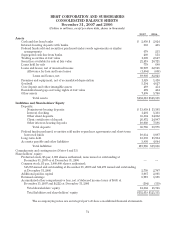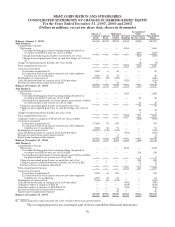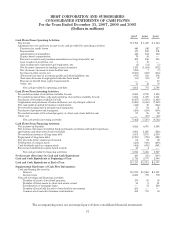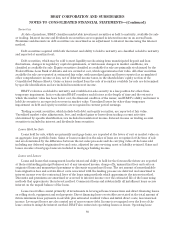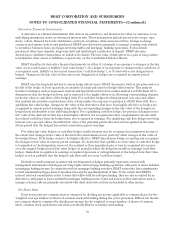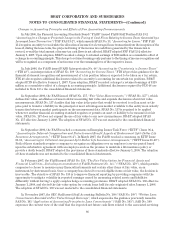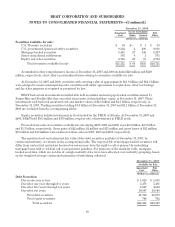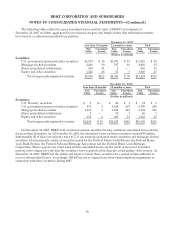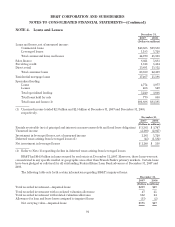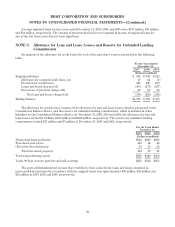BB&T 2007 Annual Report Download - page 82
Download and view the complete annual report
Please find page 82 of the 2007 BB&T annual report below. You can navigate through the pages in the report by either clicking on the pages listed below, or by using the keyword search tool below to find specific information within the annual report.BB&T CORPORATION AND SUBSIDIARIES
NOTES TO CONSOLIDATED FINANCIAL STATEMENTS—(Continued)
BB&T maintains specific reserves for individually impaired loans pursuant to SFAS No. 114. A loan is
impaired when, based on current information and events, it is probable that BB&T will be unable to collect all
amounts due (interest as well as principal) according to the contractual terms of the loan agreement. Specific
reserves are determined on a loan by loan basis based on management’s best estimate of BB&T’s exposure, given
the current payment status of the loan, the present value of expected payments and the value of any underlying
collateral.
Management’s estimate of the SFAS No. 5 component of the allowance for loan and lease losses is based on
one or more sets of observable data that management believes are most reflective of the underlying credit losses
being estimated. This evaluation is principally based on historical charge-off experience, but also includes
information derived from BB&T’s credit ratings systems; internal observable data related to trends within the
loan and lease portfolios, including credit quality, geographic, borrower and industry concentrations, aging of the
portfolio, growth and loan portfolios of acquired companies; volatility adjustments to reflect changes in historical
net charge-off rates and changes in probabilities of default; external observable data related to industry and
general economic trends; and any significant, relevant changes to policies or procedures.
The methodology used to determine the reserve for unfunded lending commitments is inherently similar to
that used to determine the SFAS No. 5 component of the allowance for loan and lease losses described above,
adjusted for factors specific to binding commitments, including the probability of funding and exposure at default.
While management uses the best information available to establish the allowance for loan and lease losses
and the reserve for unfunded lending commitments, future adjustments may be necessary if economic conditions
differ substantially from the assumptions used in performing the valuations or, if required by regulators, based
upon information available to them at the time of their examinations.
Premises and Equipment
Premises, equipment, capital leases and leasehold improvements are stated at cost less accumulated
depreciation or amortization. Land is stated at cost. In addition, purchased software and costs of computer
software developed for internal use are capitalized provided certain criteria are met. Depreciation and
amortization are computed principally using the straight-line method over the estimated useful lives of the
related assets. Leasehold improvements are amortized on a straight-line basis over the lesser of the lease terms,
including certain renewals which were deemed probable at lease inception, or the estimated useful lives of the
improvements. Capitalized leases are amortized by the same methods as premises and equipment over the
estimated useful lives or lease terms, whichever is less. Obligations under capital leases are amortized using the
interest method to allocate payments between principal reduction and interest expense. Rent expense and rental
income on operating leases is recorded using the straight-line method over the appropriate lease terms.
Securities Sold Under Repurchase Agreements
Securities sold under repurchase agreements generally have maturities ranging from 1 day to 36 months.
Securities sold under agreements to repurchase are reflected at the amount of cash received in connection with
the borrowing. The terms of repurchase agreements may require BB&T to provide additional collateral if the fair
value of the securities underlying the borrowings declines during the term of the agreement.
Income Taxes
Deferred income taxes have been provided when different accounting methods have been used in
determining income for income tax purposes and for financial reporting purposes. Deferred tax assets and
liabilities are recognized based on future tax consequences attributable to differences arising from the financial
statement carrying values of assets and liabilities and their tax bases. In the event of changes in the tax laws,
deferred tax assets and liabilities are adjusted in the period of the enactment of those changes, with the
cumulative effects included in the current year’s income tax provision.
82




